How much could your ecommerce store be losing from a poor search experience?
According to recent research, 75% of consumers will abandon your site after an unsuccessful search—costing online retailers over $300 billion a year.
And while functionality of your ecommerce search bar is of the utmost importance, so is overall UX. A clunky, vague search experience is just as dangerous to your bottom line as trusting a product discovery solution that’s not built for ecommerce use cases.
Here’s how to make your search bar experience as smooth as possible so you can increase your chances of hitting key business metrics this year.
Table of Contents
Search Bar Optimization Starts With Understanding Your Users
In its most basic form, a search bar in ecommerce is meant to facilitate the product discovery experience for consumers, helping them find the right product in less time.
But aside from this well-known fact, search bars also tell your merchandising team a lot about consumer behavior.
Basically, think of queries entered into your ecommerce search bar as a non-stop customer research project. Any and all information can be used to tailor your search experience to consumers, and this information can be bucketed into qualitative or quantitative data.
Qualitative Data
If you were to sit a few customers down in front of your website and ask them to perform a search, a few common patterns would stick out. These patterns can give you the data you need to guide your search optimization strategy.
Synonyms, contextual words, misspellings, etc.
Having a geographically diverse consumer base naturally leads to intentional or accidental variations in search queries.
Aside from synonyms and misspellings, consumers can also use descriptive words or adjectives in their queries, like “shoes for the beach” or “fancy shoes for women.”
These types of search queries often aren’t indexed properly by older internal search engines built to match keywords. But a modern product search engine, like that of Kmart Australia, can better understand these phrases and return attractive results for the specific consumer, based on prior search history and affinities.
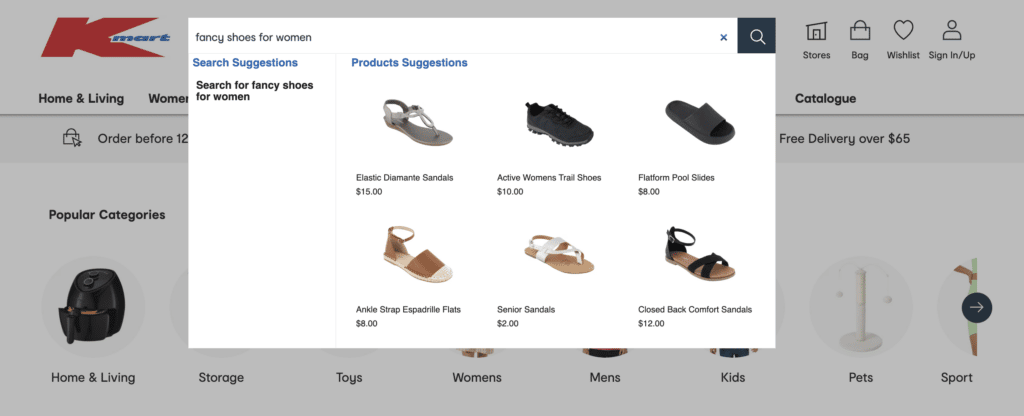
Returning attractive products
Do your users only glance at the first few search results before abandoning your site, or are they willing to browse many results pages to find what they want?
Depending on your customers’ behaviors, you might invest time in ensuring that the top search results are attractive, not just relevant.
For example, if consumers search for “jeans” on your retailer website, bell bottom jeans are technically relevant. They’re jeans. But they’re most likely not attractive for the specific consumer.
Search reformulations
Are search results attractive to consumers? If not, you may see many reformulated searches after zero results pages or a high exit rate. Likewise, how often do searches result in a null page? If they happen often, your site may not currently be capturing intent well.
Ideally, your ecommerce search bar should return relevant and attractive products to the user on the first search or soon after. For instance, they may first try a very specific search like “Asics Men’s Venture 4 shoe.” If they’re not successful, they may generalize with a brand or product-only search like “Asics.”
But because many consumers default to Google-like expectations (think: keywords) when searching for products on an ecommerce site, if your team hasn’t manually set up synonyms and other rules to correctly capture intent, you may miss out on traffic. (Multiple search attempts usually point to a need to reduce zero or frustrated searches, or suffer the hidden consequences of inaction.)
Luckily, an NLP-driven search engine can display products that each individual user is most likely to convert on based on what you know about them (from zero- or first-party data).
Quantitative Data
Information from quantitative methods like interviews and focus groups provide in-depth insights surrounding people’s emotions and thought patterns when they interact with your website. However, these methods lack the scalability needed for enterprise ecommerce sites that handle millions of daily interactions.
This is why numerical data from customer logs, product dashboards, and more is so valuable to understand large-scale customer patterns and behavior.
Clickstream Data
First-party behavioral data, or clickstream data, can help you personalize shopping experiences by measuring consumer behaviors, like add to carts, clicks, refinement rate, etc.

And because the data influences search sessions in real-time, consumers will see relevant, attractive results during their current session—within product results pages, category pages, recommendation pods, and other areas of the website your product discovery platform powers.
(And for those who want to create even more personalized, micro experiences that build brand loyalty and help shoppers make a purchase, see how to take things one step further with zero-party data.)
Log Files
You can also understand your customers by analyzing log files.
Overall search counts are among the most useful pieces of information to collect about aggregate usage. You’ll find that your search terms follow a power law distribution, where a small number of queries make up a large proportion of the total searches performed on your site. (You may also know this as the 80/20 rule.)
Since only a few queries make up a large proportion of your total searches, improving the results of these searches may provide a significant revenue lift.
The rest of the queries are “long-tail” searches that include highly specific verbiage like “no sugar added freeze-dried healthy foods.” In this case, you’ll likely need a tech solution to optimize search results rather than attempting to do it yourself.
Analytics
Aside from being user-friendly and intuitive, the right product discovery dashboard can automatically retrieve insights from the clickstream data you collect. So instead of your merchandising team having to manually go in and connect the dots for millions of daily users, it surfaces them for you 24/7.
With less grunt work, your merchandising team can focus on refining their ecommerce strategy, having a better chance at hitting important ecommerce KPIs.
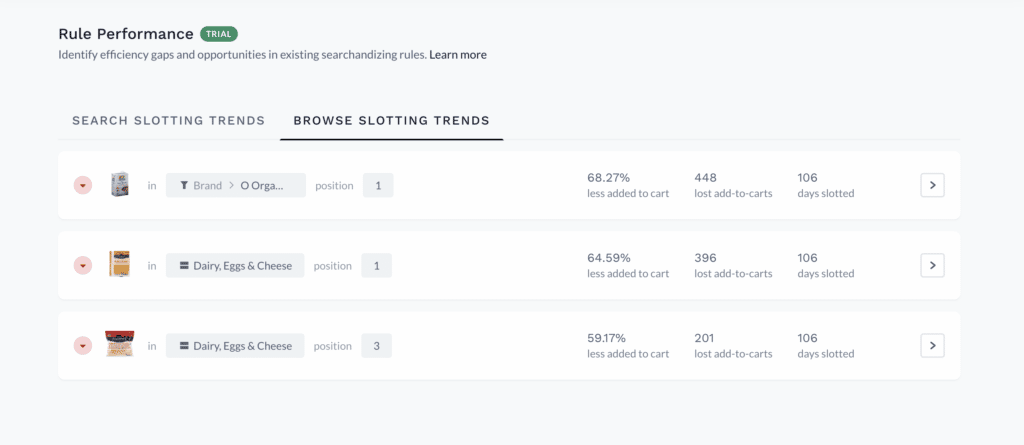
Techniques to Optimize Your Ecommerce Search Bar
Customer research is only the first step in search bar optimization. A truly world-class search experience requires a hybrid of human creativity and AI efficiency.
Search Bar Functionality
In the most basic of explanations, the purpose of an internal search engine is to give users the right results at the right time. The following tips will help you optimize your ecommerce search bar to do just that and, simultaneously, drive KPIs and maximize revenue.
Prioritize Attractiveness
Many retail sites optimize for “relevance” as the north star of ecommerce search—i.e., matching search terms with keywords in the product description drives sales. While that might work for content searches (like Netflix or news sites), it’s not true for ecommerce.
Relevance through keyword-matching is a small factor in search, but it is not an easily measurable goal. It’s also a poor way to determine what a user wants.
Imagine a consumer searches for “headphones” on an electronics website. With a keyword-based internal search engine, they might get results that are technically relevant, like those you see below from Target Australia. However, those results could still be unattractive when taking into account that consumer’s clickstream data and intent.

If the consumer previously searched for “headphones” on Target Australia, entering product description pages for over ear headphones, it’s likely they wouldn’t convert on earbuds or on ear headphones. Yet product search engines based on keywords would still return those products. Those powered by natural language processing (NLP) with clickstream analysis wouldn’t.
Keywords are also bad at describing user intent. So if a different consumer with no previous affinities nor interactions on the website searches for “headphones,” this one might also want to see earbuds. However, since the keyword “earbuds” isn’t in the product description or tagged as a synonym in the backend, an older search engine might not show earbuds, leading to a frustrated search and possible shadow churn.
Ultimately, a search bar in ecommerce has to weigh relevance and attractiveness to better meet user needs and result in a hyper-personalized search experience. But don’t take our word for it. See how Target Australia achieved a 14.8% lift in search purchase rates by personalizing results.
Offer Autosuggest, autocorrect, and visual autocomplete
Detecting and correcting user typos with good autocorrect is critical. Some of the most effective autocorrect is powered by Natural Language Processing. It corrects errors based both on keyboard layout and pronunciations. So as the NLP learns, users can get what they want as early as the first search.
Another best practice is to enable Autosuggest, which provides users with attractive suggestions faster than a user can type.
But users don’t always respond merely to words, yet images as well. So a bonus best practice for your ecommerce search bar is to offer visual autocomplete, like Backcountry does in the image below.
Visual autocomplete shows a preview of products within the search functionality of your site. It works in conjunction with autocorrect and Autosuggest. Our data validates this method, as image-embedded product listings are two times more likely to convert users.
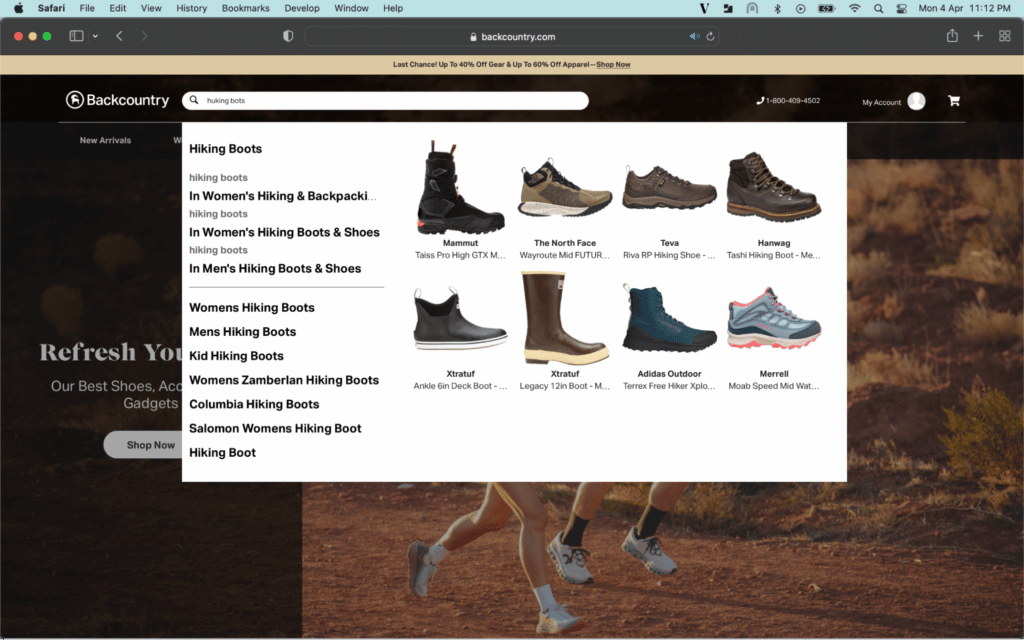
Achieve larger lifts with simple changes.
Discover our top 5 autocomplete UX best practices that have increased conversions.
Reduced zero and frustrated results
A common issue with older, keyword-based search engines is “no results” pages when a query is misspelled, contains synonyms, etc. To fix this, merchandising teams dedicate hours of their time to manually setting up redirects and synonyms.
But a solution like Cognitive Embeddings Search reduces costly zero results and frustrated searches by providing results, even for obscure and long-tail searches. It displays the right results by using layers of deep learning to map product catalogs as a “sea of stars.”
This is useful in a few scenarios:
- If a customer isn’t sure what a product is called, they can get useful suggestions. For instance, if they’re looking for a jacket with epaulets and instead type “jacket with shoulder flaps,” they’re likely to get a result.
- When comparing costs between different retailers, a customer might copy and paste long product names looking for similar products. An NLP-powered search engine can take something as specific as “ALMO Men’s Regular Fit Organic Cotton Melange T-Shirts” found on Amazon and return organic cotton t-shirts in search results.
The end result? Satisfied customers, more conversions, and higher revenue from search.
Leverage first- and zero-party data
Since privacy regulations and device restrictions ensued, ecommerce companies are now struggling to market to customers based on personal information. Yet 71% of customers expect companies to deliver personalized interactions, and even more are frustrated when it doesn’t happen.
This is where first- and zero-party behavioral data steps in.
First-party data is passively collected from your customers themselves, instead of via abstract data points defined by a third-party advertising platform—i.e., cookies. (And by the end of 2024, Google will stop allowing third-party cookies in Chrome anyways.)
Across your ecommerce platform, you probably already collect first-party data—think: contact information from your CRM, email activity like opens and clicks, and clickstream data from your search solution (pictured below).
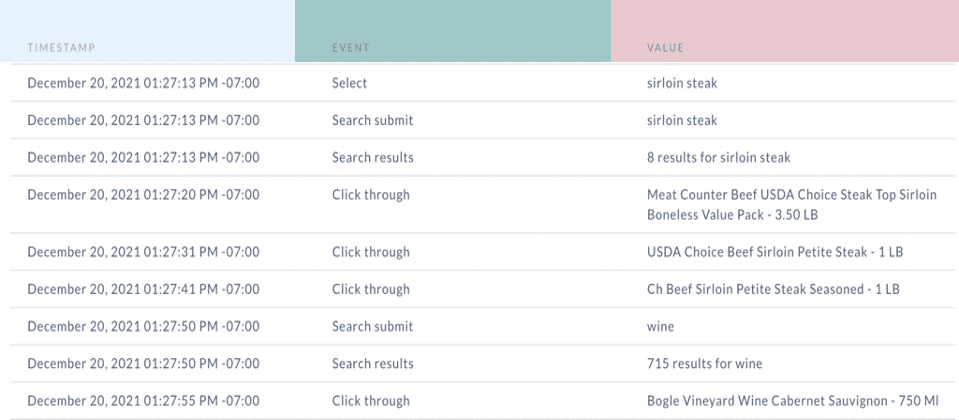
And then there’s zero-party data, which goes deeper than first-party data in the fact that it actively gathers information from your customers. In other words, they’re voluntarily telling you their wants and needs.
A perfect example of this is via product recommendation quizzes. By answering a few questions, quizzes help customers find the right products in a specific category, empowering them to purchase with confidence while simultaneously improving your conversion rates and revenue per visitor (RPV).
In other words, think of Quizzes as in-store assistants with deep domain knowledge who walk your customers through difficult purchasing decisions in a matter of seconds.
Interface and Visual Design
Your ecommerce search bar should also be visually appealing and easy to use. Here are some design best practices.
Consider label, position, and color of your ecommerce search bar
Place your search bar prominently in the top middle or top right of your site, where users expect to find it. It’s also helpful to display a clickable search icon and the word “search” as ghost text in the search bar, just as Bonobos does below.
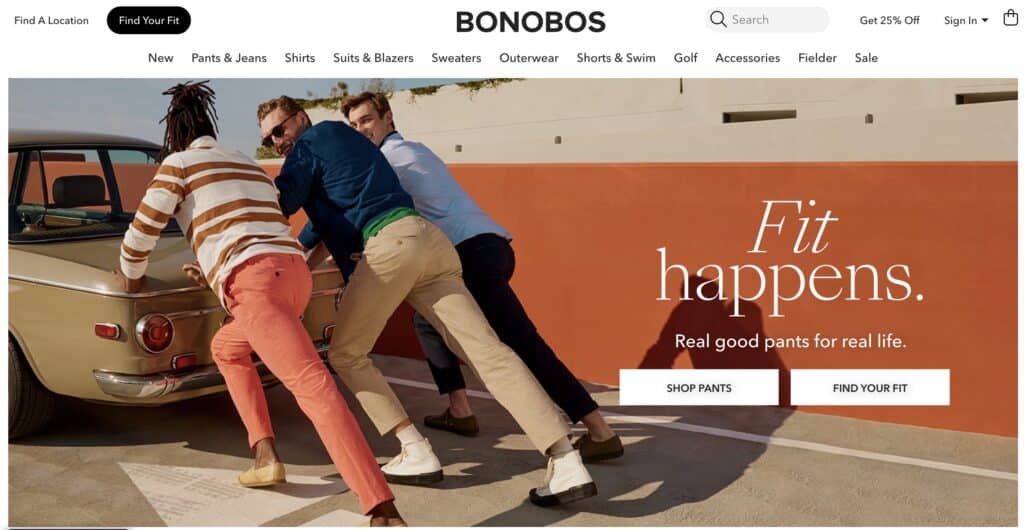
And don’t be afraid to test different colors. SwimOutlet changed theirs to blue to draw attention to it (pictured below). The simple introduction of this new feature to their site contributed to a 3.68% lift in RPV.
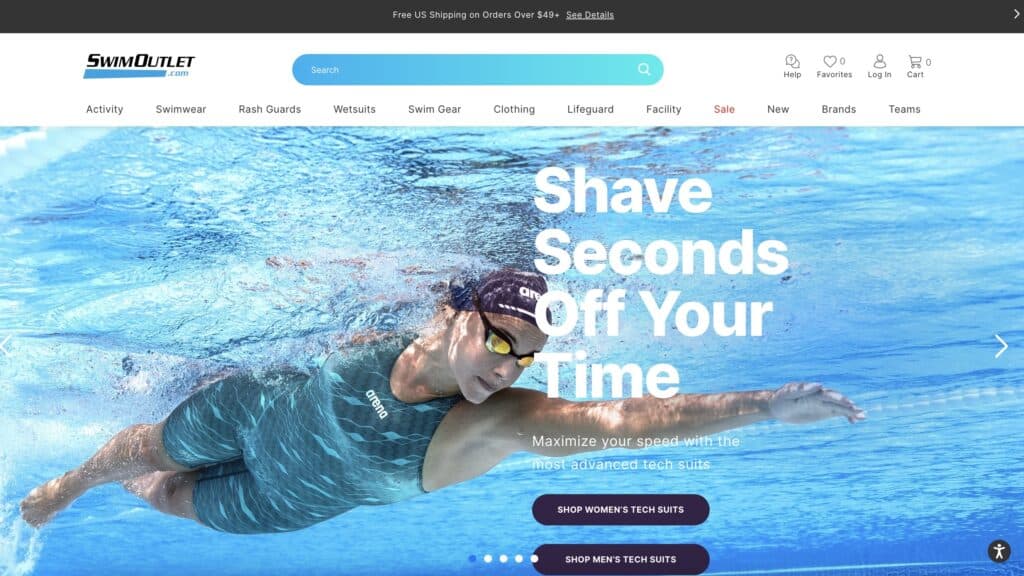
Use Sticky Search
A sticky menu, which is permanently “stuck” to the top of the page even if the customer scrolls down, is another useful search bar optimization tactic.
It ensures that a customer can search for what they need when they don’t find what they’re looking for via browsing. It’s also a fail-safe for customers to find their way out if they get lost in your website.
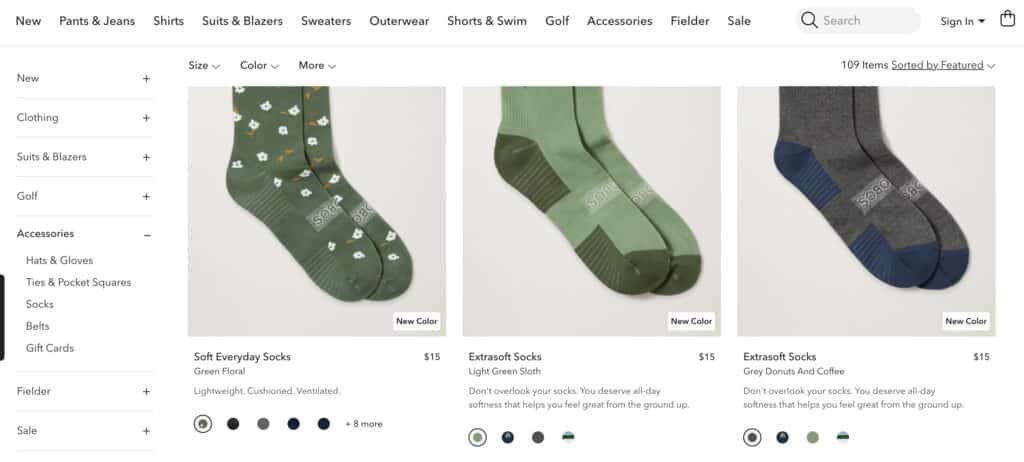
Check your fonts
Using custom, unexpected fonts is off-putting to users. When it comes to usability, conformity trumps creativity. Use a standard sans serif font in your search bar.
Don’t worry too much about matching the rest of the fonts on your site. They’re designed to be for the site’s content. It’s ok for your search bar to have a more standard look and feel.
Size your ecommerce search bar well
Make sure your search bar is wide enough for most of your user’s queries. It feels clunky to type in a search and not be able to see your entire query. Look through your search logs and size your search bar so that 95% of your users’ queries fit into it.
Mobile Optimization
As millennials age and digital-native Gen Z grows in purchasing power, an optimized ecommerce search bar should be mobile optimized.
There are a few things you can do to optimize your search bar for mobile ecommerce:
PRIORITIZE SEARCH OVER NAVIGATION
Even though cellphones are growing in size, mobile remains a difficult medium to interact with. Most phone screens are constantly moving around and hard to read in the sun. For that and other reasons, mobile conversions are about half those of desktop in ecommerce websites.
So one mobile optimization is to prioritize search over navigation. Instead of providing a suite of options to browse, mobile ecommerce sites should have simple navigation with large images and prominent search.
A large, visible, and well labeled search bar backed by robust functionality is non-negotiable today. But many mobile commerce companies with poor search actually hide their search functionality. For instance, resale fashion app Curtsy previously made their search less conspicuous because it would cause a return of poor results and lost revenue—until a better search and discovery platform led them to a 10% lift in search conversion rate and a 14.5% drop in reformulated searches.

Consider Mobile Search UX
Most customers using mobile phones are still used to pressing “Enter” to execute search commands. Users should be able to press “return” in order to search, in addition to pressing the search icon or button. It’s part of muscle memory. A further step is to label the return button on the keyboard “search” when searching on mobile devices, leading to more explicit button intent.
OFFER VOICE SEARCH
It seems like Siri and Alexa are now part of everyday existence. Beyond cell phones, hearing devices are seen on our countertops and living rooms. No wonder 91% of brands are investing in voice search.
Because voice search is more colloquial than keyword-based search, most voice searchers aren’t returned the right products in your catalog. People are more likely to say “hey alexa, get me some cheap headphones” than “headphones less than 40 dollars.”
But an internal search engine that automatically maps voice phrases; sorts products by business KPIs and user intent; and automatically applies filters can increase your mobile conversions.
Complexity in Simplicity
A search bar is a deceptively simple thing. It’s an open field full of possibilities for your users. Which is why forward-thinking companies are optimizing their ecommerce search bar — from functionality to design — so that users get what they want in less time.
Achieve larger lifts with simple changes.
Discover our top 5 autocomplete UX best practices that have increased conversions.

